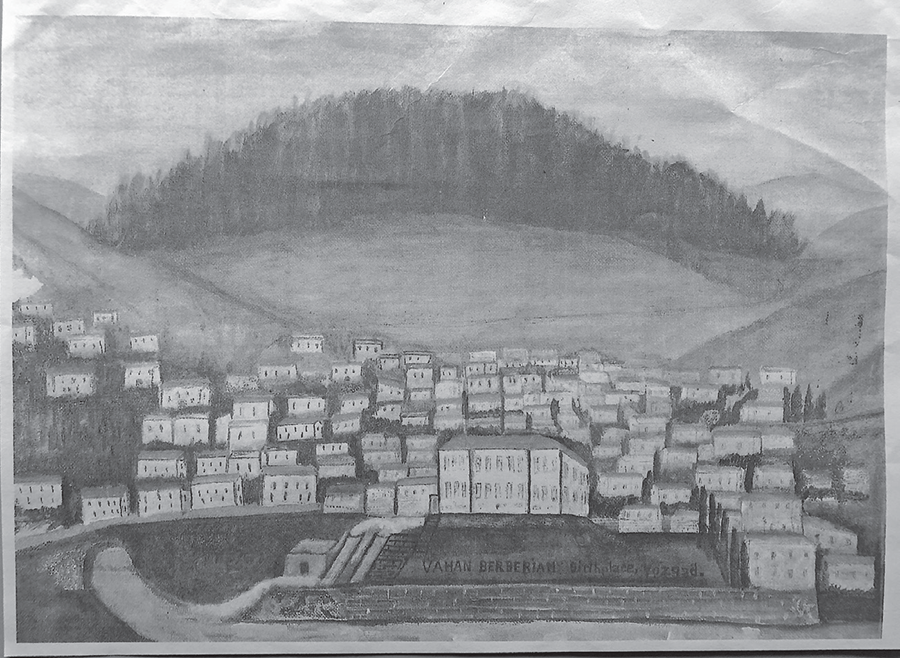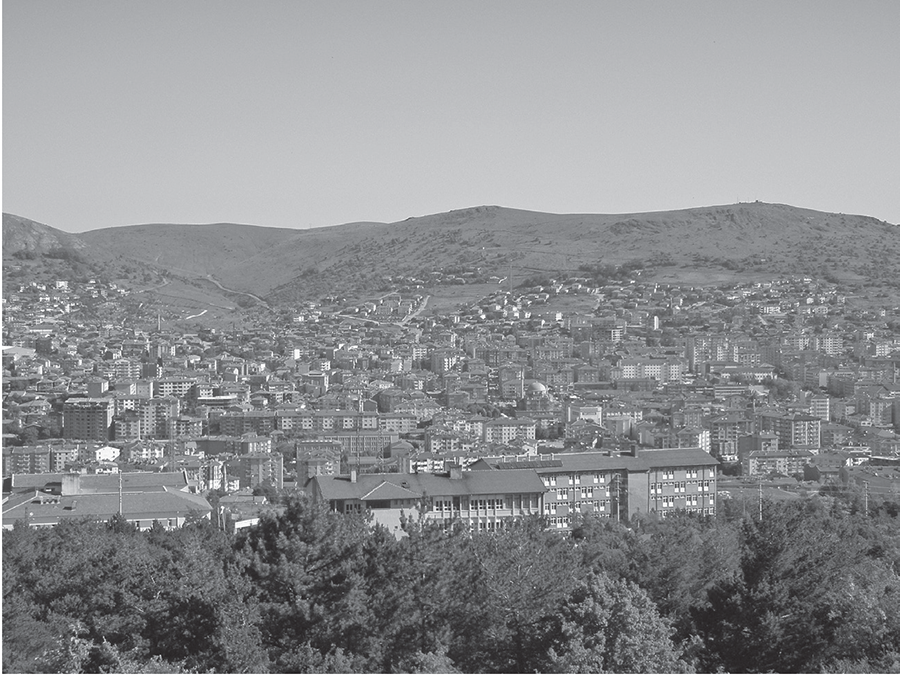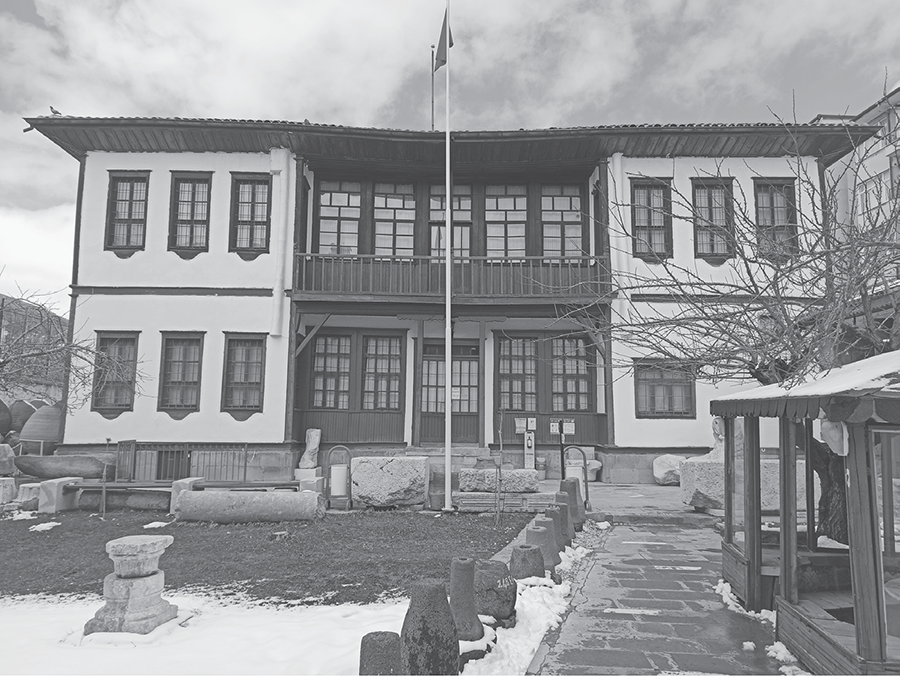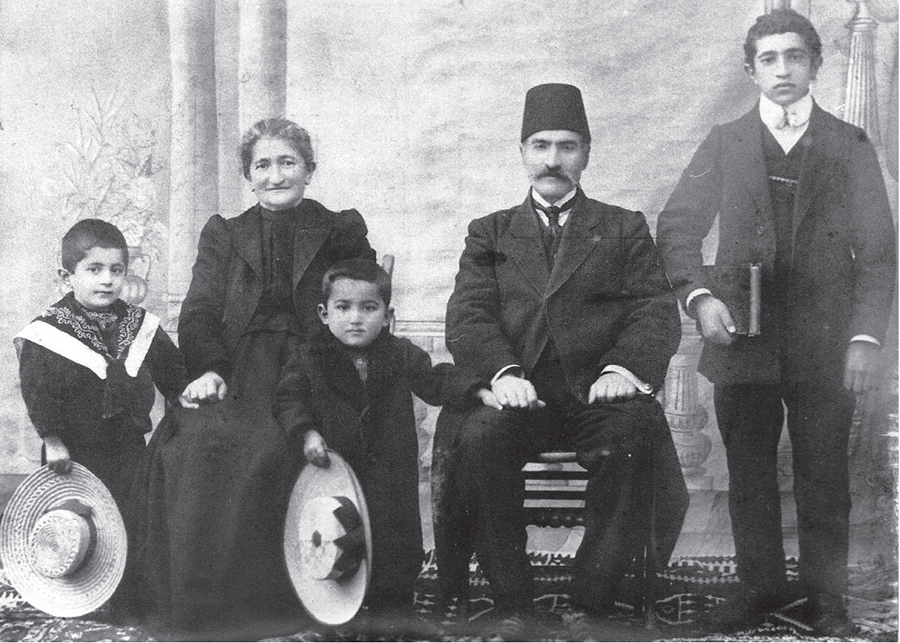WHEN MARY ANN showed me what she had brought in her suitcase, I began to grasp the powerful intimacy of each pilgrim’s search for their ancestral house. In a thick blue folder, Mary Ann had gathered an array of items that were markers of deeply profound memory-stories. She would confront these stories where they had taken place, and I would watch as their meanings changed for her, in surprisingly satisfying ways. We were traveling in a caravan of two minibuses led by Armen Aroyan, heading to towns and villages in Anatolia where each of twelve pilgrims hoped to find their family house.
Our first town on that trip was Mary Ann’s ancestral town of Yozgat, just above the geographical center of Anatolia. Mary Ann’s father, Badrig Arakelian, had been born in Yozgat in 1909. His family had lived there for generations, and it was believed that a great mansion had been part of the family’s property until 1915. Our caravan reached Yozgat in the late dusk of a summer’s day. Mary Ann sat holding the blue folder’s most cherished possession, a painting of Yozgat by her great-uncle Vahan, showing pine-covered mountains and a substantial town along the river in the valley below (Figure 2). That night, it was too dark to do more than imagine the scene outside. However, when Mary Ann awoke in the Hotel Çamlik (Pinetree Hotel) in the pine-covered mountains of her uncle’s memory, she opened the window to a view that confirmed that she was in the right place. Aroyan, having been shown Uncle Vahan’s painting, had called ahead to Yozgat to arrange that her room would have this view. She sighed. Her husband, Ed, took a photograph of what she saw (Figure 3). Mary Ann considered the painting a kind of map, and she had hoped to find the huge building that her uncle had depicted by the river. But the Kızılırmak River (T: Alis; the ancient Halys) could no longer be a clue as, alas, it had been diverted underground. Slowly, she also realized that the large building Uncle Vahan had painted could not have been their family mansion, as she had imagined, but probably was an Ottoman government building. Finding the actual house would require some help.

Of all the pilgrims I have known, Mary Ann was the most prepared for this search. Safely kept within her blue folder, along with a copy of her uncle’s memory painting, were copies of letters; fragments of family memoirs; an invitation to a 1907 Yozgat family wedding; a Yozgat insurance receipt from 1908; and a hand-drawn Yozgat family tree. She had also packed a collection of photographs. Like her other items, each photograph had a local, Ottoman Yozgat family story to tell. She also carried a notebook, and made continuous, copious notes, which she later shared with me. The things she carried were a burden for her. Even before the group reached Yozgat, Mary Ann would rifle through her folder, with a palpable anxiety. She had shown it to Armen Aroyan as soon as they met in Istanbul, wanting to make certain that he understood how each item contained the weight of her history, and that—in her small window of time in Yozgat—all must be brought to their own rightful place.

Aroyan’s sleuthing had found that the family house had survived, preserved as an ethnographic museum (Figure 4). Although its Armenian history was no longer a part of its narrative, and did not appear in the official brochure, it was known to its staff as the Arslanian home.1 According to the family tree she carried with her, Mary Ann’s great-great-great-great-grandfather, Ohan Çorbacı Arslanian, and his family had been one of the founding families of Yozgat, and Arslanian had been her paternal great-grandmother’s family name. Mary Ann surmised that when Uncle Vahan left for America in 1910, he had left from this house. Except for a niece, and the nephew who would become Mary Ann’s father, he saw none of his family again. But the house seemed to confirm what she had heard from her father and her uncle: the family had been prosperous, and their pre-genocide life had been happy. “I felt like it was just like what I was told,” she said, “but I always thought it was an exaggeration; you know, we were wealthy, we were this and we were that. But this is what they were talking about!” In her trip journal, she wrote: “The interior of the museum home was just as magnificent as the exterior and depicted a very wealthy, comfortable existence for the family. The museum was furnished as it was at the turn of the century with many original and beautiful art works and details on the walls, cabinet and ceiling reliefs.”

For Mary Ann, the mansion gave place to her images and memory-stories, that is, to the stories she had heard from her family. Here, she could emplace items from her folder, such as her grandparents’ 1907 wedding invitation and wedding photo, in a context of affluence. But the details of the past also evoked the people who had told her these stories, and even the places where those stories were told and heard. She also referred to her Uncle Vahan’s oral history, taken in America, to stories he had written down, and to a letter he had received in 1913 from his father, who had remained in Yozgat. And so, in Yozgat, not only the stories told by her father and by her uncle but even a bit of Philadelphia became a part of the house that welcomed Mary Ann that day.
“We would visit that uncle [in Philadelphia], and he would tell us the same stories.” Holding her folder, she continued: “This uncle from Philadelphia did these paintings and documented things in the stories. He wrote a story. He wrote it. I brought it along. I have it. I showed you the letter!” At another time she said: “I heard these stories from my uncle every summer. Being an only child, I had the advantage of being with the adults. That’s what you did—you visited the relatives. If it weren’t for him passing on all this material to me years back, I would have known nothing.” “I was his favorite,” she added.
Mary Ann had not brought all her family photos to Yozgat, but later she showed me the photograph of her two daughters meeting their great-great-uncle Vahan. “They met him when he was in his 90s. When they walked in and saw him, they froze in their tracks. ‘Oh, my gosh, he looks just like grandpa!’ They sat at his feet and stared.” She chose that photo to show me because it was on that visit to Philadelphia, with her children, that Uncle Vahan took out the picture of his own parents in Yozgat, no doubt sent to him in America by his father before 1915. In it, Mary Ann’s own father, Badrig, at about the age of three and carrying a large white Panama hat, is holding the hand of his well-dressed grandfather, who is wearing a Turkish fez (Figure 5).
Mary Ann lovingly called this photo the “Panama Hat Picture.” Perhaps it was taken in 1912, just before Badrig, his parents, two sisters and a young aunt (perhaps to help with the young children) had moved from Yozgat, in the center of Anatolia, to Samsun, on the Black Sea. In Samsun in 1915 came what every Armenian family feared, the knock on the door that meant the men of the family would be taken into “custody,” and then disappear. Badrig’s mother, pregnant with her fourth child, took her young daughters in search of her husband, never to be seen again. Badrig and his aunt, however, survived a long and arduous escape, finally making it to Pennsylvania, where they were greeted by Uncle Vahan.

Her uncle had wanted to give her the original photo, but Mary Ann couldn’t bear to take it from him, so she made a copy; and a copy of this copy came along on the trip.
When the “Panama Hat Picture” returned home to Yozgat, it arrived with its new accumulation of associations and memories from Mary Ann’s life in the United States. Here, as she began to experience the house in Yozgat as home, Mary Ann could add to those associations, reassembling her memory yet again. Mary Ann wrote in her journal, “There, in one of the upstairs salons, was a turn of the century organ with a Mason and Hamlin Boston label, which I felt was truly a sign to me, as a church organist, that this was my family home and also that it was welcoming me back.” Later she added, “Imagine, an organ, and from Boston!” (Mary Ann grew up and still lives in the greater Boston area.) “I was also astonished to see the Singer sewing machine and felt it was another sign, since Uncle Vahan and my father were tailors.” And then she further recalled, as if this sign were not clear enough, that another Yozgat great-aunt who had made it to America was the one who “would sew and design all my flower girl dresses.”
In some ways, the museum house was an assembled memory of its own, as museum houses rarely exhibit a moment in time. Rather, they are conscious installations that attempt to reproduce an image of time. Thus, having been made into a depersonalized, anonymous, generic icon of an era, even if this house were Mary Ann’s house, it also was not. Yet when Mary Ann came upon the sewing machine, the organ, and the stage-like settings in its furnished rooms, its ghost came to life, making images not unlike her photographs—to which Mary Ann had assigned meaning by giving them captions. These would join the other items and stories she carried, generating a new configuration of memory.
Tim O’Brien’s short story “The Things They Carried,” in which he considers soldiers and their experiences of Vietnam, describes the very visceral connections between the personal items carried into battle and the soldiers’ emotional histories, and does so in a way that parallels the power radiated by the items brought by the pilgrims in this book. In O’Brien’s story, the things they carried were objects such as first-aid kits and love letters, and the stories these items elicited disclosed the emotional burdens and soulful yearnings of the soldiers’ experience of war. Thus, the meaning of that place, Vietnam, is what we are to extract from that story’s heady combination of emotion-laden objects and images.
However, when items such as Mary Ann’s photo of her father as a child, with all its personal memories, are brought to the place where the photograph was taken, the experiential meaning, even the affective truth, of the ancestral house is not just revealed, it is constructed. Furthermore, by reassembling memories and memory-stories, this meaning is understood, even experienced, in a way that allows it to become a part of Mary Ann’s story: In her poetic imagination, that sewing machine was “as if” it had been used by her father, her uncle, and even her aunt, all of whom had escaped to tell about it. There might even have been a moment when everything seemed to shift, a type of reverie or realm in which, as the philosopher Edmund Husserl might suggest, Mary Ann’s imagination was able to stand apart from “the pitfalls of naturalistic positing,”2 or the lining up of facts. Husserl’s contemporary, Gaston Bachelard, a philosopher concerned with the emotional resonance of houses, might even have predicted that when Mary Ann’s imagination added new images to old, she would experience a shift that was driven by deep, even poetic truths. “Imagination,” wrote Bachelard, “is not, as its etymology would suggest, the faculty of forming images of reality; it is rather the faculty of forming images which go beyond reality, which sing reality.” In fact, for Bachelard, when our imaginations confront our houses, which are made up of “dispersed images and a body of images at the same time, . . . imagination augments the values of reality.”3 As Mary Ann began to meld the images she had brought with her with those she was experiencing, it became possible for her, imaginatively, to move back in.
Yet for Mary Ann, the finding of her family house was also a tense moment, as she could find no acknowledgment that it was an Armenian house, let alone hers. Instead, it had become a marker of a homogenized Turkish history, signaled by the Turkish flag that stood in front of it. If history had not been what it was, she might have shown her photographs to the receptionist or to the armed guards at the door. Mary Ann’s husband, Ed, however, looking at the two Turkish-speaking guards, had no desire to use her family’s photographs in an attempt to replace past appropriations with new commonalities. Instead, with his ever-present wit, and feeling sure that they would not understand, he said to them, in clear English, “This is my wife’s house and you are fired!” Mary Ann, on the other hand, at least in the moment, was less engaged than her husband with the loss of the house and the genocide that caused it, or with the Turkish denial that erased its history; instead, her experience disclosed potential healing. It could not heal what had happened to her family, nor change the reasons why she never knew her own grandmother, but by giving her house a positive and personal meaning, it could heal some of the separation between her present self and her ancestral past. Experiencing the house through the lens of an amalgam of new and old memory images had brought the house from death to life, making it available as a gift to the future.
The next day, as the caravan of pilgrims moved on to other towns, she said to Aroyan, “I just want to tell you how comfortable it felt yesterday, and I was very proud of this beautiful location, that they had the life that they had there, and proud that they made such a nice life for themselves; they accomplished a lot in the short time that they had”; the unspoken ending being: “in this homeland that we can never live in again.”
1. Mary Ann does not have title deeds. She bases her supposition on Armen Aroyan’s understanding that this house was locally known as “the Arslanian House” and is in a formerly Armenian neighborhood. Now officially named the Nizamoğlu Konağı (Nizamoğlu Mansion), the house was restored and made a museum after being donated to the Ministry of Culture by the Nizamoğlu family. Although the museum information states that it was built in 1871, the original owner and builder is not made clear.
2. Husserl, as discussed and quoted in Birinde, “Moving Images of Home.”
3. Bachelard, Poetics of Space, 15.